
Last Updated on
By John Buol
How much improvement can a shooter gain with just fifteen minutes of daily dry practice?
Highly skilled capabilities are possible only to those willing to invest time in training and practice. In Outliers, Malcolm Gladwell spelled out the “10,000-Hour Rule” repeatedly stating that the key to success in any field requires study, practice, and commitment that will eventually expend thousands of hours of time invested. Skill with a firearm is simple, provided you’re willing to invest the time analyzing, performing and reanalyzing each move, in slow motion and at full speed, thousands of times. One reason shooting is a superior sport is because you can practice and analyze at home for no cost. Its called dry practice.
Dry practice is the act of shooting and gunhandling without live ammo. Unfortunately, and for no good reason, too many gun owners treat dry practice like the weather: Something everyone discusses but few do anything about. Most authors discussing technique conclude with a dubious tip like, “You need to practice to become good.” Some recommend dry firing for a few minutes a day.
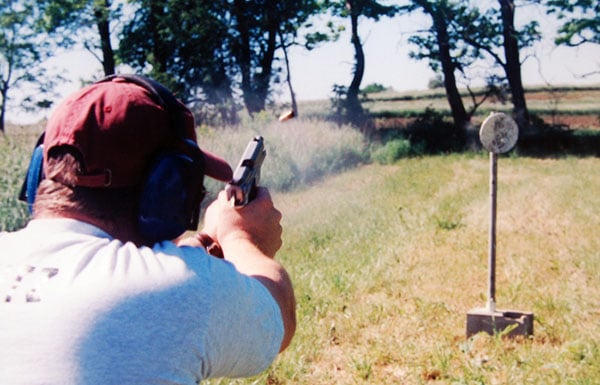
This is all true but it’s just lip service to the true importance and effectiveness of dry practice. Instead of just talking about it, let’s find out how important such practice is. How much improvement can you realistically expect to make with fifteen minutes per day?
To answer this question, I set up some experiments. My brother, Jason, and I were back home for a period. He was in the area for awhile, so I asked if he’d like to do a little shooting with me. Jason had been a semi-active shooter for one summer, which culminated in participating at a local Steel Challenge-type match with me. However, he hadn’t shot for years since, having taken up golf instead (ugh!) Jason was interested but mentioned he didn’t have much spare time. An experiment was born. Given a moderate amount of dry practice, how much improvement can we expect to see?
First, we’ll start with equipment. Assuming you use something suitable that isn’t out-and-out junk, equipment is a relatively small factor in your overall performance. However, being a website for gun owners, I know the reader is interested in such detail. Jason used the only pistol and shooting gear he owned, a stock six-inch Smith and Wesson 586 .357 Magnum topped with an Tasco AccuDot optical sight with a four minute dot. The rig was all Safariland, 002 “Cup Challenge” holster, Comp III speed loaders and pouches mounted on inner-outer Velcro belt. Ammo was a handload I made for him consisting of a 158 grain LSWC bullet with enough Hodgdon Clays to push it 800 feet per second. All the equipment was good quality, albeit ordinary, so it won’t hold up improvement.
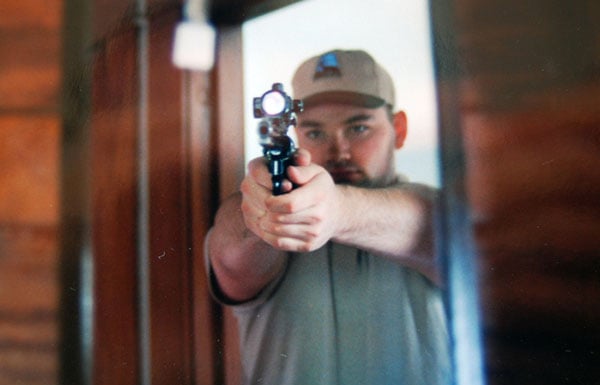
With gear taken care of we’ll look at the important part: The practice regimen. To establish a baseline, I needed to know his “before” skills. After checking for safe gun handling through dry fire, we shot the following drills:
- Slow fire group of 6 rounds at 25 yards standing, two hands.
- 12 inch plate at 10 yards, timed from ready.
- 12 inch plate at 10 yards, timed draw.
At the first session, Jason’s slow fire groups averaged nine inches, his timed shots from ready averaged 1.55 seconds and 2.6 seconds from the holster for reliable hits. The speed drills were timed with an electronic shooting timer (PACT IV Championship Timer) on an unanticipated signal and everything was recorded on video. The draws were from the “surrender” position (wrists above shoulders) and all shots, including slow fire groups, were fired double action.
For the record, Jason had previously shot seriously for one spring and summer which culminated into attending a local Steel Challenge-type event, hadn’t touched a gun for several years since. Saying he felt “rusty” is an understatement, even though his performance was better than plenty of police officers and military personnel I’ve shot with. In addition, this was Jason’s first exposure to using a scope sight, having bought and mounted it on a whim after the match but then never practicing with it. That slowed him down. Technology can help only if you use it efficiently!
Shooting problems displayed were classic novice errors. He had a tendency to blink his eyes on discharge, to lose the dot while presenting towards the target and to dip or “scrunch” his head on the draw. Also, due to inexperience and a long lay off, Jason was uncomfortable “stacking” the double action, so he waited until the gun stopped before starting the long trigger pull on timed shots. This caused a long delay before the shot broke.
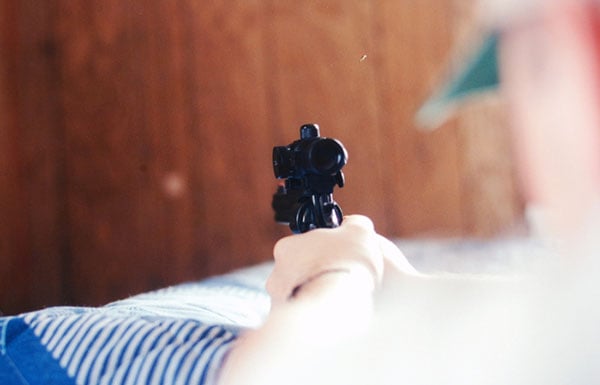
After the live session, we reviewed the video, discussed the results and made a plan for improvement. The most vital part of any practice routine is a written schedule. Over the course of the month, Jason worked on basic marksmanship with a little gun handling. His routine was:
- 25 slow-fire shots without a target, arms rested across a table to focus on grip and trigger control.
- 25 slow-fire shots without a target, standing to work on stance and trigger control.
- 25 presentations and shots from ready to target, untimed.
For his convenience, Jason took broke this into three separate five minute sessions and took about 15 minutes per day total. He found a place he could practice without interruption every day. The aiming point for presentations was a one inch square taped to a bullet proof wall in his practice place. At three feet away, this roughly simulates a ten inch target at ten yards. Jason found breaking this up into small, quick sessions helped maintain his focus. At first, he took breaks during the standing and presentations from ready parts to rest his forearms but quickly found that as improvement occurred, this wasn’t necessary.
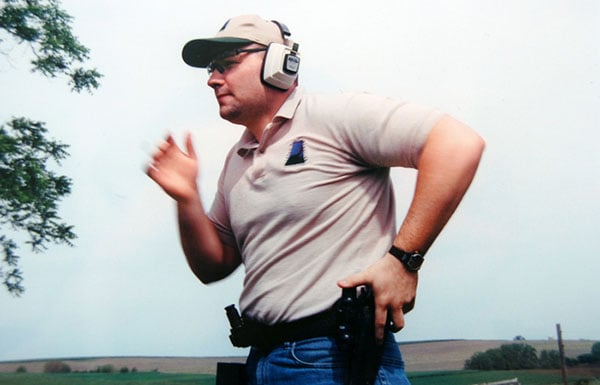
After four weeks of dry practice we tested again using the same standards. Again the session was recorded on video. In slow fire, Jason was now averaging just under six inch groups at 25 yards. Having spent two thirds of his dry practice time in learning how to shoot his revolver again paid off by greatly improving his accuracy. On the ready presentation drill he averaged 1.1 seconds for a reliable hit, with good runs pushing close to one second. That is almost a half second improvement to the first shot. Shots from the holster showed nearly equal improvement, moving down to a 2.1 average with good ones pushing two seconds, or about 0.4 seconds faster.
After shooting, we reviewed both sessions on video. Looking past the raw data, there were many intangible improvements. The video proved Jason was now handling his revolver with notably more relaxed confidence. We were both pleased with the results.
It’s important to note that these live fire sessions weren’t really training or practice, merely skill evaluation. Jason fired about 100 live rounds total in both sessions. The real benefit came from dry practice alone. The improvements shouldn’t be surprising considering he “fired” more than 2,100 rounds evenly spaced over a four week period. Especially note his improvement on the draw. Jason did nothing to practice this directly, but the simple act of handling the gun everyday and presenting from ready gave an improvement. In any athletic endeavor, familiarity breeds competence.
We modified the schedule based on Jason’s notes and to incorporate improving the draw. In order to keep the session length the same, we modified the schedule:
- 5 shots standing, slow fire
- 10 presentations and shots from ready
- 10 “grips” (move from wrists above shoulders to a grip on the gun)
- 20 full draws
This all took about five minutes and Jason did this three times daily. Notice he first practiced the pieces (slow shots to warm up, presentations from ready to the target, hands to the gun) and then blended the parts together at the end. Nothing was rushed or timed. Jason simply went through each motion paying attention to form, a consistent presentation to the target, perfect sight alignment and smooth trigger control. Shots from ready and the full draws were presented to a one-inch target at three feet, with some practice done in a mirror to gain second person perspective.

After about four more weeks, we headed out for a third live fire session. His good results were becoming monotonous. Grouping accuracy at 25 yards again improved, now averaging just over five inches at 25 yards. Presentations from ready were consistently one second flat, with some good ones in the low 0.9s, yielding a ten percent improvement. Draw times dropped as well, averaging in the 1.8 second range for a fifteen percent jump in skill.
This improvement occurred for a number of reasons. The first, and most important, is that the shooter was willing to put in regular, scheduled, disciplined practice. It was only a few minutes a day, but Jason actually did it, everyday, instead of just talking about it, and followed through with his usual high work ethic. If he cheated anything it would have been doing a little more practice than reported. Most gun owners have the opposite problem. Working as an instructor for both military and police personnel, the most difficult task is getting people to do the work.
If this level of progress seems high, consider he fired about 5,900 “shots” in two months (2,100 and 3,780, respectively) not counting actual live fire. More importantly, Jason didn’t mindlessly click the gun or slop through the gun handling. Shots were deliberate, sessions were kept short to maintain sharp focus, and he often jotted down a few notes after each session. Sometimes the daily journal entry was a single line in the notebook, but he took the time to evaluate and write down something every day. Sessions were deliberately kept short so a high level of focus could be maintained.
Good coaching or mentoring helps. While Jason’s coach wasn’t/isn’t an expert (whatever that is), he has earned Master and Distinguished classifications in multiple disciplines from several national-level shooting organizations. Jason didn’t have to dig through dozens of books or DVDs and stumble through, learning from his his own mistakes as he went. He had an experienced hand, with actual, proven skill levels, teaching and evaluating technique, and coaching during live fire. Even in formal training, especially in police, military and tactical environments, most instructors aren’t held to any type of significant skill requirement and the poor results, if they’re ever measured, show.
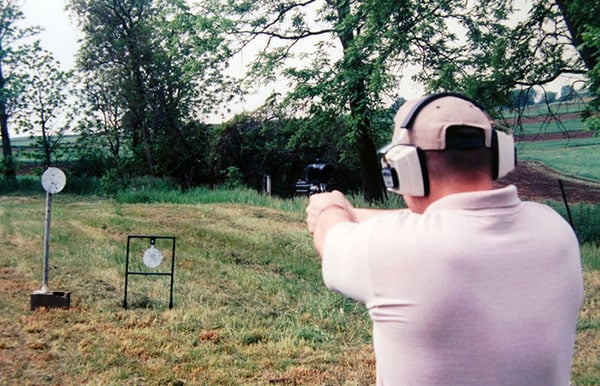
The live sessions were recorded on video and played back immediately afterward for evaluation. Faults were corrected during initial instruction so he didn’t unknowingly practice a poor technique or use bad form for a month before finding the error. When a student can actually see their performance they become self-teaching. It is easy to show faults and suggest improvements.
This level of improvement is not unusual. Obviously, results begin to taper as the shooter becomes more skilled but improvement continues for as long as the shooter maintains a disciplined training regimen. It doesn’t take too much time and if you’ll work like Jason did, your shooting will significantly improve as well.




Leave a Reply